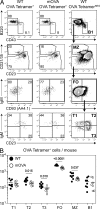Deletion and anergy of polyclonal B cells specific for ubiquitous membrane-bound self-antigen
- PMID: 23071255
- PMCID: PMC3478923
- DOI: 10.1084/jem.20112272
Deletion and anergy of polyclonal B cells specific for ubiquitous membrane-bound self-antigen
Abstract
B cell tolerance to self-antigen is critical to preventing antibody-mediated autoimmunity. Previous work using B cell antigen receptor transgenic animals suggested that self-antigen-specific B cells are either deleted from the repertoire, enter a state of diminished function termed anergy, or are ignorant to the presence of self-antigen. These mechanisms have not been assessed in a normal polyclonal repertoire because of an inability to detect rare antigen-specific B cells. Using a novel detection and enrichment strategy to assess polyclonal self-antigen-specific B cells, we find no evidence of deletion or anergy of cells specific for antigen not bound to membrane, and tolerance to these types of antigens appears to be largely maintained by the absence of T cell help. In contrast, a combination of deleting cells expressing receptors with high affinity for antigen with anergy of the undeleted lower affinity cells maintains tolerance to ubiquitous membrane-bound self-antigens.
Figures








References
-
- Borrero M., Clarke S.H. 2002. Low-affinity anti-Smith antigen B cells are regulated by anergy as opposed to developmental arrest or differentiation to B-1. J. Immunol. 168:13–21 - PubMed
Publication types
MeSH terms
Substances
Grants and funding
LinkOut - more resources
Full Text Sources
Other Literature Sources
Molecular Biology Databases

